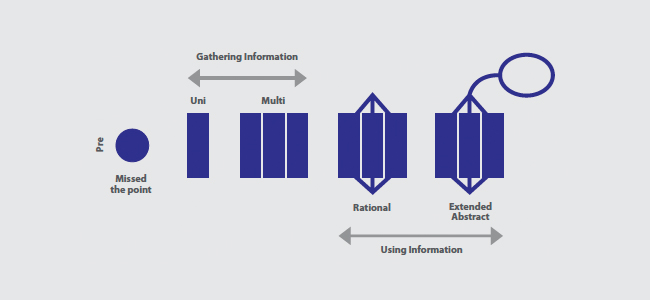SOLO LEVEL: PRESTRUCTURAL (the pupil has missed the point)

PUPIL RESPONSE:
I think Johnny Depp is a Shakespeare character because we watched a film featuring both of them.
TO MOVE ON:
The pupil must begin to gather basic information on the topic. He has clearly not understood that Johnny Depp is an actor, and knows of no choices Mr Depp has made.
UNISTRUCTURAL

PUPIL RESPONSE:
Johnny Depp acts in films.
TO MOVE ON:
The pupil has understood one choice Johnny Depp has made, but there is no further detail. The pupil should conduct further research into the actor’s career and the different roles he has played.
MULTI STRUCTURAL

PUPIL RESPONSE:
I know lots about the life and times of Johnny Depp. I know the films that he has acted in. I know that he dislikes mainstream films. He has acted in some mainstream films.
TO MOVE ON:
The pupil must begin to make links between the information he has found about Johnny Depp’s life and the choices he has made as an actor.
RELATIONAL

PUPIL RESPONSE:
Johnny Depp is a popular actor who first came to our screens in the 1980s. At this time, cinema was very popular. Johnny, however, decided to shun the bright lights of Hollywood, opting instead for less mainstream roles, in films such as What’s Eating Gilbert Grape?
TO MOVE ON:
The information gathered has been linked contextually. The pupil should analyse and question his findings, and draw his own conclusions about what he has discovered.
EXTENDED ABSTRACT

PUPIL RESPONSE:
Johnny Depp is a popular actor who first came to our screens in the 1980s. This was a time when cinema was very popular. Johnny, however, decided to shun the bright lights of Hollywood, opting instead for less mainstream roles, in films such as What’s Eating Gilbert Grape? Was this conscious decision to avoid the limelight actually just a clever tactic to engage the interest of potential fans from niche groups? Let us look through his career history to find out…
TO MOVE ON:
The pupil has linked his knowledge, examined it in greater detail and theorised about Johnny Depp’s choices. He should always seek out new ways to develop and apply what he has learnt.
Implementing SOLO
By providing a clearly defined path to higher-order thinking, SOLO makes self- and peer-assessment easier. In my experience, with various year and ability groups, including sixth form and bottom sets, once pupils have been taught the features of each SOLO level and how it leads to the next, they are quickly able to use the system to develop sophisticated ideas about almost any topic.
Because it is a highly structured approach, SOLO must be introduced accurately. Ensure that you fully understand the idea before using it in the classroom. Create examples like those in this article in order to establish how the approach can be used within your subject. If you are confused, what hope do your pupils have of “getting it”?
In particular, pupils must recognise the differences between the levels, and the importance of each level. Multistructural may be a “lesser” form of understanding than relational, but it is a necessary precursor to it: one cannot relate multiple facts without first gathering them. Be sure to explain each stage’s place in the sequence of thinking. If pupils already have good knowledge of a topic, they may need less time for multistructural research, but it is still necessary to acknowledge its importance - if only for when they encounter a topic about which they at first know very little.
It is also important that your initial question be accessible, and that it enables pupils to develop their answer to the extended abstract level. When I first used SOLO with my year nine class, I began by posing the question “Did Shakespeare write every story ever written?” A typical response was “No, but he wrote lots of plays”.
At this point, I introduced SOLO and explained that such a response was unistructural if correct, but prestructural if it missed the point.
Next, I explained that the pupils’ existing knowledge of Shakespeare (not their single-sentence answers but the other things they already knew) was multistructural. I got them to write everything they knew about Shakespeare and his plays on large pieces of paper, and I gave them some further facts before we moved on.
Having thus established multistructural knowledge, we moved on to relating the facts and ideas they had written down. I asked the pupils to compare Shakespeare with a modern writer and to use their knowledge of Shakespeare’s times and modern times to compare and contrast the work of the two writers.
Finally, I asked the pupils to question their findings further. I provided them with question stems to encourage them to explore various points of view about the comparisons that they had made. By questioning their relational ideas, they were able to start creating new, educated conclusions about their explorations.
This extended abstract stage can be reached only when the pupil becomes knowledgeable enough about a topic to hypothesise about it with logic and evidence. Pupils are unlikely to reach this level in a single lesson.
The Benefits
One-sentence or single-word answers are common responses from pupils, and we usually accept them if they are correct. After grasping the principles of SOLO, however, pupils begin to think more carefully about the quality of their answers. They realise that one-word responses are unistructural and therefore less valuable than answers that draw links between several facts or observations.
To get the most out of SOLO, use it widely and daily. It can be applied to many tasks, such as setting desired learning outcomes and assessing the level of thinking that has gone into pupils’ work. You can also give pupils instant feedback on their oral responses by using the symbol for the SOLO level that an answer has reached. The more I use the approach, the more valuable I find it.


















